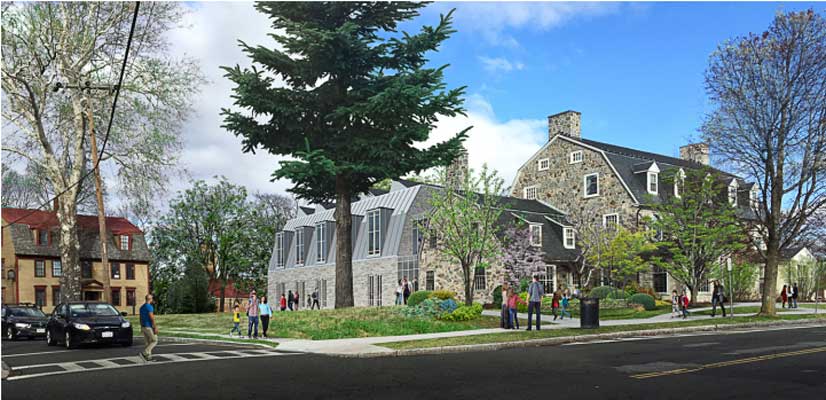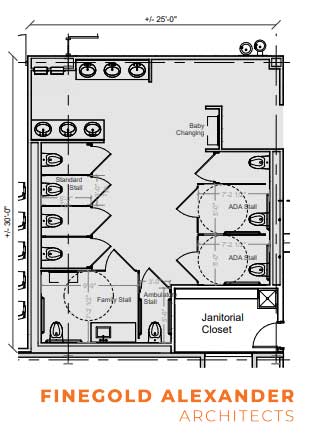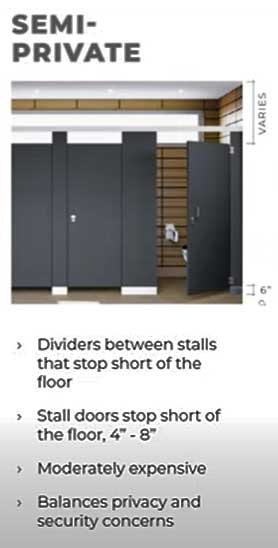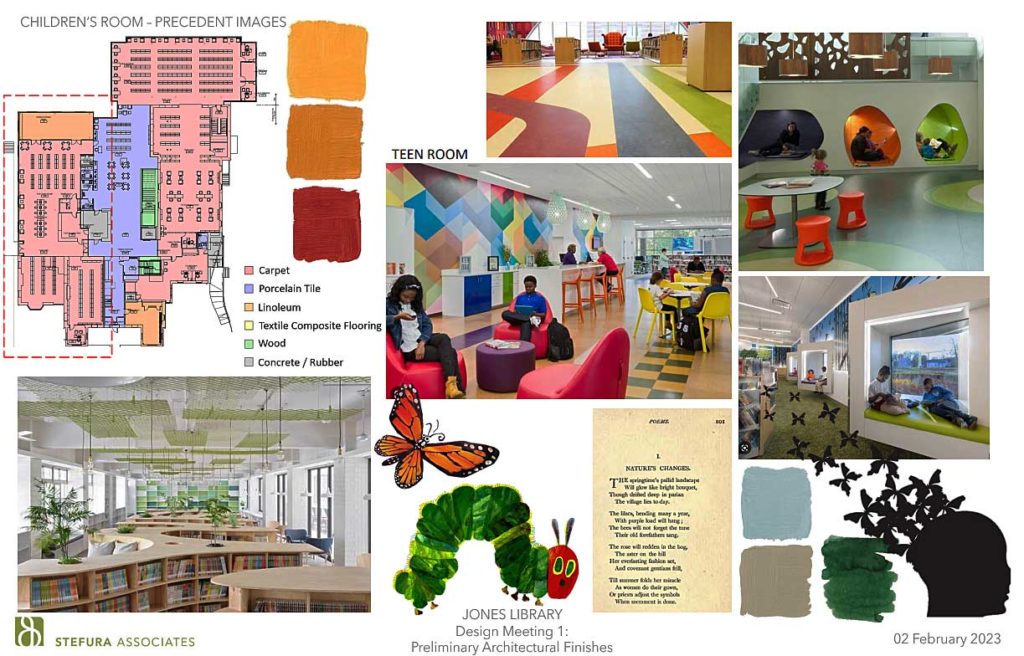Bathroom Decision Stalls Library Design. Historic Compatibility Questioned

Jones Library News Highlights For The Week Of January 30, 2023
Gender-inclusive Restrooms Will Require Variance
Settling on a design for the restrooms on the ground floor of the renovated Jones Library has proven challenging for members of the Jones Library Building Committee (JLBC) as they struggle to find the right balance between privacy, gender-inclusion, safety, accessibility, code-compliance, and cost. The restroom is to be located near the new 200-seat large meeting room that is planned to be made available to the public after normal library hours.
After two months of deliberation the JLBC decided at its February 2 meeting on either an 8-stall shared-gender design with a large family stall equipped with a sink to be relocated near the entrance, or a 9-stall design designated as Option D by Finegold Alexander Architects (FAA).

The group’s preference is the 8-stall solution to be drawn up by FAA, with the configuration proposed in Option D to be adopted if FAA finds that state plumbing code requires 9 toilets.
Both proposals were unsatisfactory to chair of the JLBC Design Subcommittee Christine Gray-Mullen who has been a steadfast advocate for a separate restroom that can be used by patrons who may not feel comfortable using a gender-inclusive restroom. Gray-Mullen was unhappy that a separate standalone family water closet which had been included in previous design schematics was removed from the most recent FAA proposal.
The decision to pursue a restroom layout that would serve all genders was made after the JLBC Outreach Committee conducted a Jones Library All-User Restroom Survey that received more than 200 responses. 40.4% of respondents had never used a multi-stall all-user restroom. 82.2% of those surveyed described themselves as cisgender (identifying with the gender they were assigned at birth).
Respondents who support the all-user restroom point out that the gender-inclusive design promotes the availability of toilets when a large number of people may be needing them. Others, however, were not sold on the idea, as indicated in this comment:
“This is a terrible idea. If this is to be used by the general public, consideration should be made for people who would not go into such a bathroom, including foreign students, the elderly, children, etc. Personally, I would not use such a bathroom. As a woman, it is comforting to know that no males will be in a public bathroom, and it would be very disconcerting to find this. People who didn’t feel comfortable would then have to go to one of the other floors to find a bathroom. Since these are planned to be single stall, there may be a wait. Women may want to do personal care in a bathroom (hair, etc.) and may not feel comfortable with men around. Some men may prefer to have a males-only bathroom as well! There are many seniors who would find this very uncomfortable; they use the library a lot and would have to trek up to one of the other floors to find a suitable bathroom.”
Gray-Mullen reminded the JLBC that Massachusetts plumbing code currently does not permit gender-inclusive restrooms without a variance.
“We’re on bleeding edge here and my understanding is the Massachusetts plumbing board is extremely conservative. They are turning down and refusing some variances,” she said.
FAA’s Ellen Anselone urged the JLBC to come to a decision. “We’ve been studying these bathrooms for six months,” she protested.
Ultimately the JLBC voted to go with a modified 8-stall “Option D” that placed a large family stall toward the front as proposed by FAA’s Tony Hsiao, as long as the number of toilets was code-compliant. Gray-Mullen was the lone no vote.
The Committee agreed that a semi-private stall design was its preference.

Source: amherstma.gov
Transition From Historic To New Section Of Library Questioned
FAA is bringing interior design firm Stefura Associates onto the project at a cost of $102,300. Stefura will be helping with interior finishes design and furniture selection.
Principle-in-Charge Lianne Vivilecchia presented slides showing Stefura’s vision for finishing the areas of the library. She envisions livening up the Children’s Room with bright colors and linoleum flooring with a pattern on it.
This prompted JLBC Chair Austin Sarat to question the compatibility of the bright color palette with the location of the Children’s Room in the historic part of the library. He recalled the FAA-designed addition to the Holyoke Public Library where he observed a stark difference between the original library and the more modern addition, and he wondered if the Jones Library design pays adequate attention to the “continuity between the historic part of the building and the new part of the building.”
Library Director Sharon Sharry responded, “Austin … do you prefer that the entire library be, in essence, classic?”
Sarat answered that he wasn’t expressing a preference, but that his sense after visiting the Holyoke Library was that the transition from historic to new was “very stark.”
Anselone of FAA exclaimed, “That was the design idea… you pass. That’s what we were trying to do.”
She added that in pursuit of historic tax credits from the state, FAA will be keeping window and baseboard trim in the original 1928 Jones Library building.
The Holyoke Public Library project, completed in 2013, reportedly failed to qualify for Massachusetts Historic Rehabilitation Tax Credits.
[See related Issues & Analyses: A Primer On Historic Rehabilitation Tax Credits For Income Producing Buildings]


The Holyoke Public Library project did not pursue Historic Tax Credits.
It did, successfully, pursue New Markets Tax Credits.
On March 15, 2012, the Holyoke Library’s application for Massachusetts Rehabilitation Tax Credits was denied, as per the attached copy of the 2-page document from the Massachusetts Historical Commission. To say the library did not “pursue” these credits is misleading because it seems that it stopped pursuing them only after being turned down, and then changed course.
It’s interesting to note that the Holyoke library, which received the same public records request from the Indy that the Massachusetts Historical Commission received, was unable to comply. The library administrator said that it cannot produce the documents because it destroyed them, as per its internal policies.
I’ll take this opportunity to correct an earlier claim of yours, too, that no Holyoke Library trustee had resigned for reasons related to the design and scope of the above renovation/expansion project. Indeed, at least one Holyoke Library trustees did so.
Finally, it would be appropriate for you to disclose, whenever it’s relevant, that you have been, and perhaps continue to be at this very moment, paid for your fundraising, development, and marketing services for the Jones Library renovation/expansion project.
https://drive.google.com/file/d/1W-Zm6nmspMGGL3MVTbu7MdTfSJhZLlQA/view?usp=share_link. (MHC / Holyoke Library Page 1)
https://drive.google.com/file/d/11tzY2ZhWOY0BsoQcXv2sP1zFjjXtgeJY/view?usp=share_link (MHC Holyoke Library Page 2)
I would add, Matt, that a 2014 writeup on the Holyoke Library project by the National Trust for Historic Preservation on their website, savingplaces.org, and which you have cited in a previous comment, reported that “The library board applied for state historic tax credits, but was rejected, in part, because of the extent of the renovation.”
And in fact, not one but two Holyoke Library directors resigned over dissatisfaction with the renovation plan — Tom Ripa and Olivia Mausel. (See Building Committee Learns From Three Library Visits)
Perhaps Mr. Blumenfeld will comment on two other fundraising issues:
(1) The 2016-17 Jones Library MBLC grant application stated that New Market Tax Credits would be pursued for this project. Is this the case?
(2) Also stated in that application is that $400,000 of the Woodbury Fund would be used to fund the project but there has been no mention of this donation since 2017. Such a line item is not listed in any fundraising information provided by the Friends of the Jones Library System, now the entity in charge of fundraising. The Friends oversee the Woodbury Fund.
https://www.joneslibrary.org/DocumentCenter/View/1960/Jones-Library-2016-2017-MBLC-Construction-Grant-Round-Application-January-26-2017-PDF?bidId= See PDF pages 83-84
… not to distract from the topic, but kudos on the headline, Jeff. I just got the pun …
Jeff.
I just reread the article that you cite /link to, and see no mention of Historic Tax Credits and HPL. I may be missing something, but I don’t see what you are referring to.
I don’t believe that the Jones will seek New Markets Tax Credits.
The quote that Jeff cited is in the article at the savingplaces.org link, about midway down, right above the photo of Jim Alexander standing next to the murals in the library.
Thank you, Mr. Blumenfeld, for answering the question about the Jones Library not applying for New Market Tax Credits.
What is the situation with the promised $400,000 pledge from the Woodbury Fund?
Thanks Denise, I see that now in the article. I don’t actually recall whether the HTC application was prepared and submitted. There was general agreement at the time that HTCs would be a long shot.
It is good to have your insider’s perspective, Matt. But if Holyoke felt that historic tax credits were a long shot, why should the Jones project fare any better?
The Jones renovation-expansion has committed to the same FAA-designed approach — knocking down the exterior wall of a historic building and attaching a large modern glass-walled addition. This does not seem to “preserve its historic and architectural significance.”
Jeff. I am glad you are raising this point.
The indications that we see are that there is a more than reasonable chance that the Jones project will qualify. In Holyoke’s case the project involved removing a visible historic element – the stack wing – which was necessary in order to “Square the T” of the library. That made the project non-eligible for MA HTCs. If you are interested in learning more, I suggest reviewing the National Park Services guidelines.
It is by no means a certainty that the Jones will succeed in obtaining MA HTCs, but there is a very reasonable chance, which makes it worth pursuing. The HTC consultant for the Jones is the same one that worked with us (FDA) and our clients (Stockbridge and Shelburne Falls) to achieve HTCs from the Commonwealth’s program.